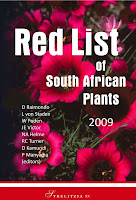The Red List online

The 2009 Red List of South African Plants was published in April 2010. Over a year has passed since this publication was produced and the status of many plant species has changed. SANBI’s Threatened Species Programme has therefore just produced the first online version of the plant Red List. This website contains all information associated with the species assessments included in the 2009 Red List of South African Plants. In addition, this new version also includes additional information on 3 604 species, 1 075 assessments have been updated, 3 283 photos have been added, and we have included distribution maps for 7 228 species. 79 newly described species have been added to the Red List, and the status of 219 species has been updated. To access information on the conservation status of South Africa’s plants please visit http://redlist.sanbi.org/.
In addition to the actual assessments for each species, the site also includes a section which summarizes the status of South Africa’s plants (see tabs at the top of the website) including statistics of how many threatened species are found in each province and each biome, the major threats, etc. A section with recommendation for EIA practitioners is also included.
It is possible to search the site for anything, e.g. a specific area like Pondoland, or a threat from rooibos tea plantings, etc.
As the Red List is used extensively for EIA assessment work, it is important that updated vrsions of it are released. The site will not be updated on an on-going basis but every six months. Use of data available on the current website needs to be cited as Red List of South African Plants version 2011.1 Please follow the citation recommendation at the base of each species record and website page.
You will note that many species (65%) do not have distribution map information available but this is due to SANBI’s PRECIS database including at least one or more erroneous distribution records for these species. We will strive to do quality checks on these data over the next few years and the number of maps available will increase with each update of the website. The 7 228 distribution maps that have been included have been checked and against published distribution data and can be relied upon.
As you use this website you will probably note that the Threatened Species Programme is not aware of specific population information that you as a field botanist may have. Please could you make use of the function comment on this assessment at the base of each record to send us information we may not be aware of. Lastly if you have photos of species that we do not yet have photos for please could you email these to l.vonstaden@sanbi.org.za and we will add them for the next release of the website.
 Quiver Tree (Aloe dichotoma). Status: Vulnerable. (A species is Vulnerable when the best available evidence indicates that it meets at least one of the five IUCN criteria for Vulnerable, indicating that the species is facing a high risk of extinction. )
Quiver Tree (Aloe dichotoma). Status: Vulnerable. (A species is Vulnerable when the best available evidence indicates that it meets at least one of the five IUCN criteria for Vulnerable, indicating that the species is facing a high risk of extinction. ) The Halfmens (Pachypodium namaquanum). Status: Least Concern. (A species is Least Concern when it has been evaluated against the IUCN criteria and does not qualify for any of the above categories. Species classified as Least Concern are considered at low risk of extinction. Widespread and abundant species are typically classified in this category.)
The Halfmens (Pachypodium namaquanum). Status: Least Concern. (A species is Least Concern when it has been evaluated against the IUCN criteria and does not qualify for any of the above categories. Species classified as Least Concern are considered at low risk of extinction. Widespread and abundant species are typically classified in this category.)
Comments